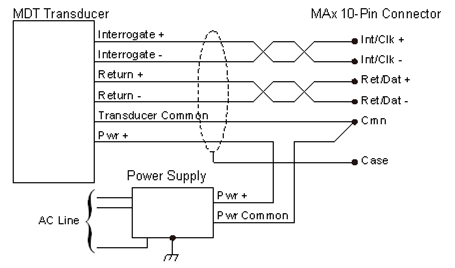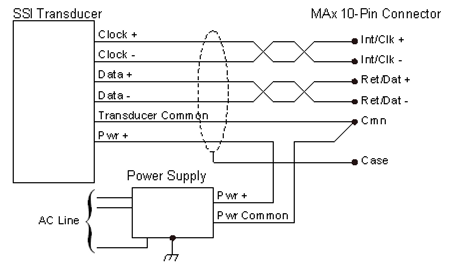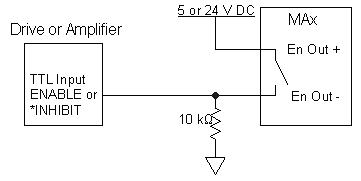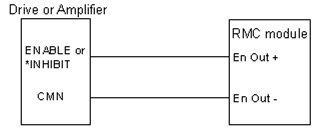
The MAx module can be wired to MDT and SSI transducers. Each axis on the MAx also has a Fault input, Enable output, and a Control output. If the MA module has two axes, each axis' pinout is identical.
Use shielded twisted pairs for all connections to inputs and outputs. Route the transducer wiring separate from other wiring. You must provide the power supplies needed by your transducers. See Wiring Guidelines for general wiring information.
Wire clamp screws must be tightened to max 7 b-in (0.8Nm).
NOTE:
The following example schematics do not include transducer pin numbers,
color codes, or power supply requirements, since these vary between different
transducers. To determine your power supply needs and connector
pin-outs or cable color codes, consult your transducer manufacturer's
documentation.
Pin-Out
|
Pin # |
MA1 Label |
MA2 Label |
Function |
|
1 |
+Fault In |
Flt In+ |
Fault Input |
|
2 |
-Fault In |
Flt In- |
|
|
3 |
+Enable Out |
En Out+ |
Enable Output |
|
4 |
-Enable Out |
En Out- |
|
|
5 |
Control Out |
Ctrl Out |
Control Output |
|
6 |
Common |
Cmn |
Common |
|
7 |
+Int/Clock |
Int/Clk+ |
MDT Interrogation or SSI Clock |
|
8 |
-Int/Clock |
Int/Clk- |
|
|
9 |
Common |
Cmn |
Common |
|
10 |
+Ret/Data |
Ret/Dat+ |
MDT Return or SSI Data |
|
11 |
-Ret/Data |
Ret/Dat- |
|
|
12 |
Case |
Case |
Connected to RMC Chassis |
The commons are internally connected.
MDT Wiring (see below for SSI)
The MAx modules interface only to transducers with Differential Line Driver (RS422) signals. Single-ended (TTL) transducers are not supported due to low noise immunity. MDT transducers connect to the following MAx pins:
|
Pin |
Function |
Additional Possible Manufacturer Designation |
|
Int/Clk + |
MDT + Interrogation |
Interrogate + Input |
|
Int/Clk - |
MDT - Interrogation |
Interrogate - Input |
|
Cmn |
MDT Common |
|
|
Ret/Dat + |
MDT + Return |
Pulse + Output |
|
Ret/Dat - |
MDT - Return |
Pulse - Output |
|
Case |
RMC75 Chassis |
|
Wiring instructions:
Connect the '+Int' and '-Int' between the transducer and the MA module for the interrogation signal.
Connect the '+Ret' and '-Ret' between the transducer and the MA module for the return signal.
Connect the transducer DC ground to Cmn. Each axis has two Cmn pins. Either of the 2 pins may be used. The Cmn must be connected to the transducer, or the signals will not be read correctly!
The transducer power supply is not provided by the RMC. The user must supply a power supply. The power supply common may be connected to the same common that is connected to the RMC75 CPU Cmn.
Diagram

SSI Wiring
SSI uses differential line driver (RS422) clock and data signals. Connect the transducer DC ground to SSI Cmn. SSI transducers connect to the following MAx pins:
|
Pin |
Function |
|
Int/Clk + |
SSI + Clock |
|
Int/Clk - |
SSI - Clock |
|
Cmn |
Common |
|
Ret/Dat + |
SSI + Data |
|
Ret/Dat - |
SSI - Data |
|
Case |
RMC75 Chassis |
Max Cable Length
|
Maximum Cable Length* |
|
|
150 kHz |
1360 ft (415 m) |
|
250 kHz |
770 ft (235 m) |
|
375 kHz |
475 ft (145 m) |
* The cable lengths are approximate, and may be affected by the type of wire and transducer.
Wiring Instructions
Connect both the +Clock and -Clock between the MA module and transducer for the clock signal.
Connect both the +Data and -Data between the MA module and transducer for the data signal.
Connect the transducer DC ground to Cmn. Each axis has two Cmn pins. Either of the 2 pins may be used. The Cmn must be connected to the transducer, or the signals will not be read correctly!
The transducer power supply is not provided by the RMC. The user must supply a power supply. The power supply common may be connected to the same common that is connected to the RMC75 CPU Cmn.
Diagram

Fault Input Wiring
The Fault input is compatible with signal levels ranging from 12V to 24V. The Fault Input draws 2.7mA maximum and turns on at 6V. The Fault input turns on when a current flows. The polarity of the voltage is unimportant. See the Fault Input topic for more details.
Fault input wiring diagrams:
|
Generic:
|
From Open Collector Output:
|
Enable Output Wiring
The Enable output is a solid state relay (SSR). When it is off, it has high impedance, and when on it has low impedance (10 Ω maximum). Because the Enable output is isolated, the user must power it externally. The maximum current and voltage for the Enable output is 100 mA and 30 V.
The Enable output has a + and - connection. Both lines must be connected for the output to function. Because both sides of the output are provided, the switches may be independently connected in a high side or low side configuration (that is, with the load (input) on the source or sinking side of the output). See the wiring diagrams below.
See the Enable Output topic for more details on the Enable Output.
To TTL input (high = enable):

To active low Enable input:

Using Outputs with Inductive Loads
External fuses should be used to protect the SSRs if there is a possibility of over-current. When switching inductive loads, it is important to place a diode or tranzorb across the load to protect the switch when transitioning from an “ON” to an “OFF” state. Otherwise, the collapsing magnetic field can cause a reverse voltage spike in excess of the 30 V rating of the SSR.
Control Output Wiring
The valve or motor drive connects to the following MAx pins:
|
Pin |
Function |
|
Control Output |
Control Output |
|
Cmn |
Control Output Common. Each axis has two Cmn pins. Either of the 2 pins may be used. |
See the Control Output topic for more details on the Control Output.
Note:
The Control Output polarity can be set with the Invert
Output Polarity parameter.

See Also
Copyright © 2025 Delta Computer Systems, Inc. dba Delta Motion